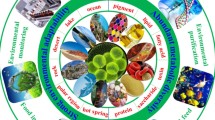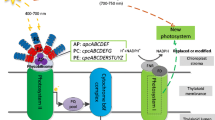Abstract
Cyanobacteria can produce useful renewable fuels and high-value chemicals using sunlight and atmospheric carbon dioxide by photosynthesis. Genetic manipulation has increased the variety of chemicals that cyanobacteria can produce. However, their uniquely abundant NADPH-pool, in other words insufficient supply of NADH, tends to limit their production yields in case of utilizing NADH-dependent enzyme, which is quite common in heterotrophic microbes. To overcome this cofactor imbalance and enhance cyanobacterial fuel and chemical production, various approaches for cofactor engineering have been employed. In this review, we focus on three approaches: (1) utilization of NADPH-dependent enzymes, (2) increasing NADH production, and (3) changing cofactor specificity of NADH-dependent enzymes from NADH to NADPH.

Similar content being viewed by others
References
Parmar A, Singh N K, Pandey A, Gnansounou E, Madamwar D. Cyanobacteria and microalgae: A positive prospect for biofuels. Bioresource Technology, 2011, 102(22): 10163–10172
Machado I M, Atsumi S. Cyanobacterial biofuel production. Journal of Biotechnology, 2012, 162(1): 50–56
Nozzi N E, Oliver J W, Atsumi S. Cyanobacteria as a platform for biofuel production. Frontiers in Bioengineering and Biotechnology, 2013, 1: 1–6
Deng M D, Coleman J R. Ethanol synthesis by genetic engineering in cyanobacteria. Applied and Environmental Microbiology, 1999, 65(2): 523–528
Dexter J, Fu P. Metabolic engineering of cyanobacteria for ethanol production. Energy & Environmental Science, 2009, 2(8): 857–864
Gao Z, Zhao H, Li Z, Tan X, Lu X. Photosynthetic production of ethanol from carbon dioxide in genetically engineered cyanobacteria. Energy & Environmental Science, 2012, 5(12): 9857–9865
Choi Y N, Park J M. Enhancing biomass and ethanol production by increasing NADPH production in Synechocystis sp. PCC 6803. Bioresource Technology, 2016, 213: 54–57
Kusakabe T, Tatsuke T, Tsuruno K, Hirokawa Y, Atsumi S, Liao J C, Hanai T. Engineering a synthetic pathway in cyanobacteria for isopropanol production directly from carbon dioxide and light. Metabolic Engineering, 2013, 20: 101–108
Lan E I, Liao J C. Metabolic engineering of cyanobacteria for 1-butanol production from carbon dioxide. Metabolic Engineering, 2011, 13(4): 353–363
Lan E I, Liao J C. ATP drives direct photosynthetic production of 1-butanol in cyanobacteria. Proceedings of the National Academy of Sciences of the United States of America, 2012, 109(16): 6018–6023
Atsumi S, Higashide W, Liao J C. Direct photosynthetic recycling of carbon dioxide to isobutyraldehyde. Nature Biotechnology, 2009, 27(12): 1177–1180
Angermayr S A, Paszota M, Hellingwerf K J. Engineering a cyanobacterial cell factory for production of lactic acid. Applied and Environmental Microbiology, 2012, 78(19): 7098–7106
Varman A M, Yu Y, You L, Tang Y J. Photoautotrophic production of D-lactic acid in an engineered cyanobacterium. Microbial Cell Factories, 2013, 12(1): 1–8
Zhou J, Zhang H, Meng H, Zhang Y, Li Y. Production of optically pure D-lactate from CO2 by blocking the PHB and acetate pathways and expressing D-lactate dehydrogenase in cyanobacterium Synechocystis sp. PCC 6803. Process Biochemistry, 2014, 49(12): 2071–2077
Angermayr S A, Van der Woude A D, Correddu D, Vreugdenhil A, Verrone V, Hellingwerf K J. Exploring metabolic engineering design principles for the photosynthetic production of lactic acid by Synechocystis sp. PCC6803. Biotechnology for Biofuels, 2014, 7(1): 1–15
Li C, Tao F, Ni J, Wang Y, Yao F, Xu P. Enhancing the light-driven production of D-lactate by engineering cyanobacterium using a combinational strategy. Scientific Reports, 2015, 5: 1–11
Miyake M, Takase K, Narato M, Khatipov E, Schnackenberg J, Shirai M, Kurane R, Asada Y. Polyhydroxybutyrate production from carbon dioxide by cyanobacteria. Applied Biochemistry and Biotechnology, 2000, 84–86(1-9): 991–1002
Tyo K E, Jin Y S, Espinoza F A, Stephanopoulos G. Identification of gene disruptions for increased poly-3-hydroxybutyrate accumulation in Synechocystis PCC 6803. Biotechnology Progress, 2009, 25(5): 1236–1243
Zhou J, Zhu T, Cai Z, Li Y. From cyanochemicals to cyanofactories: A review and perspective. Microbial Cell Factories, 2016, 15(1): 1–9
Wang Y, San K Y, Bennett G N. Cofactor engineering for advancing chemical biotechnology. Current Opinion in Biotechnology, 2013, 24(6): 994–999, 99
Akhtar MK, Jones P R. Cofactor Engineering for enhancing the flux of metabolic pathways. Frontiers in Bioengineering and Biotechnology, 2014, 2: 1–6
Tamoi M, Miyazaki T, Fukamizo T, Shigeoka S. The calvin cycle in cyanobacteria is regulated by CP12 via the NAD(H)/NADP(H) ratio under light/dark conditions. Plant Journal, 2005, 42(4): 504–513
Cooley J W, Vermaas W F. Succinate dehydrogenase and other respiratory pathways in thylakoid membranes of Synechocystis sp. strain PCC 6803: Capacity comparisons and physiological function. Journal of Bacteriology, 2001, 183(14): 4251–4258
Dempo Y, Ohta E, Nakayama Y, Bamba T, Fukusaki E. Molarbased targeted metabolic profiling of cyanobacterial strains with potential for biological production. Metabolites, 2014, 4(2): 499–516
Hirokawa Y, Maki Y, Tatsuke T, Hanai T. Cyanobacterial production of 1,3-propanediol directly from carbon dioxide using a synthetic metabolic pathway. Metabolic Engineering, 2016, 34: 97–103
Li H, Liao J C. Engineering a cyanobacterium as the catalyst for the photosynthetic conversion of CO2 to 1,2-propanediol. Microbial Cell Factories, 2013, 12(1): 1–9
Oliver J W, Machado I M, Yoneda H, Atsumi S. Cyanobacterial conversion of carbon dioxide to 2,3-butanediol. Proceedings of the National Academy of Sciences of the United States of America, 2013, 110(4): 1249–1254
Savakis P E, Angermayr S A, Hellingwerf K J. Synthesis of 2,3-butanediol by Synechocystis sp. PCC 6803 via heterologous expression of a catabolic pathway from lactic acid-and enterobacteria. Metabolic Engineering, 2013, 20: 121–130
Niederholtmeyer H, Wolfstadter B T, Savage D F, Silver P A, Way J C. Engineering cyanobacteria to synthesize and export hydrophilic products. Applied and Environmental Microbiology, 2010, 76(11): 3462–3466
McNeely K, Xu Y, Bennette N, Bryant D A, Dismukes G C. Redirecting reductant flux into hydrogen production via metabolic engineering of fermentative carbon metabolism in a cyanobacterium. Applied and Environmental Microbiology, 2010, 76(15): 5032–5038
Kumaraswamy G K, Guerra T, Qian X, Zhang S, Bryant D A, Dismukes G C. Reprogramming the glycolytic pathway for increased hydrogen production in cyanobacteria: Metabolic engineering of NAD+-dependent GAPDH. Energy & Environmental Science, 2013, 6(12): 3722–3731
Jarboe L R, Yqh D. A broad-substrate range aldehyde reductase with various applications in production of biorenewable fuels and chemicals. Applied Microbiology and Biotechnology, 2011, 89(2): 249–257
Wee Y J, Kim J N, Ryu H W. Biotechnological production of lactic acid and its recent applications. Food Technology and Biotechnology, 2006, 44(2): 163–172
Joseph A, Aikawa S, Sasaki K, Tsuge Y, Matsuda F, Tanaka T, Kondo A. Utilization of lactic acid bacterial genes in Synechocystis sp. PCC 6803 in the production of lactic acid. Bioscience, Biotechnology, and Biochemistry, 2013, 77(5): 966–970
Polizzi K M, Chaparro-Riggers J F, Vazquez-Figueroa E, Bommarius A S. Structure-guided consensus approach to create a more thermostable penicillin G acylase. Biotechnology Journal, 2006, 1(5): 531–536
Terao Y, Miyamoto K, Ohta H. Introduction of single mutation changes arylmalonate decarboxylase to racemase. Chemical Communications, 2006, 34(34): 3600–3602
Vázquez-Figueroa E, Chaparro-Riggers J, Bommarius A S. Development of a thermostable glucose dehydrogenase by a structure-guided consensus concept. ChemBioChem, 2007, 8(18): 2295–2301
Jochens H, Bornscheuer U T. Natural diversity to guide focused directed evolution. ChemBioChem, 2010, 11(13): 1861–1866
Ema T, Nakano Y, Yoshida D, Kamata S, Sakai T. Redesign of enzyme for improving catalytic activity and enantioselectivity toward poor substrates: Manipulation of the transition state. Organic & Biomolecular Chemistry, 2012, 10(31): 6299–6308
Holmberg N, Ryde U, Bulow L. Redesign of the coenzyme specificity in l-lactate dehydrogenase from bacillus stearothermophilus using site-directed mutagenesis and media engineering. Protein Engineering, Design & Selection, 1999, 12(10): 851–856
Ma C, Zhang L, Dai J, Xiu Z. Relaxing the coenzyme specificity of 1,3-propanediol oxidoreductase from Klebsiella pneumoniae by rational design. Journal of Biotechnology, 2010, 146(4): 173–178
Richter N, Zienert A, Hummel W. A single-point mutation enables lactate dehydrogenase from Bacillus subtilis to utilize NAD+ and NADP+ as cofactor. Engineering in Life Sciences, 2011, 11(1): 26–36
Meng H, Liu P, Sun H, Cai Z, Zhou J, Lin J, Li Y. Engineering a Dlactate dehydrogenase that can super-efficiently utilize NADPH and NADH as cofactors. Scientific Reports, 2016, 6: 1–8
Steiner K, Schwab H. Recent advances in rational approaches for enzyme engineering. Computational and Structural Biotechnology Journal, 2012, 2(3): 1–12
Li Y, Cirino P C. Recent advances in engineering proteins for biocatalysis. Biotechnology and Bioengineering, 2014, 111(7): 1273–1287
Acknowledgements
This research was supported by the Marine Biotechnology Program (Marine BioMaterials Research Center) funded by the Ministry of Oceans and Fisheries, Korea, and BK21+ program through the National Research Foundation of Korea funded by the Ministry of Education, Science and Technology. This work was also conducted under the framework of Research and Development Program of the Korea Institute of Energy Research (KIER) (B4-2474-02).
Author information
Authors and Affiliations
Corresponding author
Rights and permissions
About this article
Cite this article
Park, J., Choi, Y. Cofactor engineering in cyanobacteria to overcome imbalance between NADPH and NADH: A mini review. Front. Chem. Sci. Eng. 11, 66–71 (2017). https://doi.org/10.1007/s11705-016-1591-1
Received:
Accepted:
Published:
Issue Date:
DOI: https://doi.org/10.1007/s11705-016-1591-1




